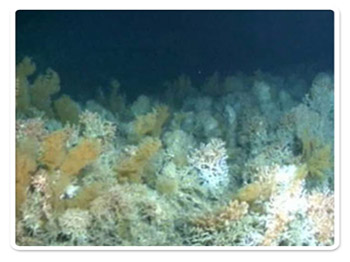 Carbonate mounds Carbonate mounds
Carbonate mounds are one of the 5 deep-sea habitats listed by OSPAR as threatened and / or declining.
 Carbonate mounds are a unique combination of cold-water coral framework and rubble, sediment deposition and local hydrodynamic conditions. They take the form of large sediment mounds which have an internal composition of cold-water coral, usually Lophelia pertusa or Madrepora oculata or a combination of both, foraminiferal ooze / marl and deposited sediment. Carbonate mounds form isolated or clustered provinces of seabed knolls measuring up to 350 metres in height at depths of 600-900 metres, corresponding to the mid-slope of the continental margin. Carbonate mounds are a unique combination of cold-water coral framework and rubble, sediment deposition and local hydrodynamic conditions. They take the form of large sediment mounds which have an internal composition of cold-water coral, usually Lophelia pertusa or Madrepora oculata or a combination of both, foraminiferal ooze / marl and deposited sediment. Carbonate mounds form isolated or clustered provinces of seabed knolls measuring up to 350 metres in height at depths of 600-900 metres, corresponding to the mid-slope of the continental margin.
Almost all of these mounds alter the local hydrodynamic forces, favouring filter-feeding organisms such as corals and sponges. The fast-flowing currents support vast banks of living cold-water coral, between which large areas rich in gorgonians and stylasterid corals are common.

|
